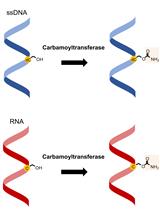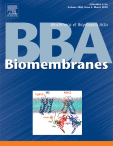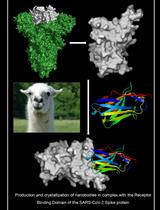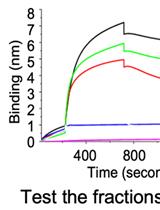- EN - English
- CN - 中文
Expression and Ni-NTA-Agarose Purification of Recombinant Hepatitis C Virus E2 Ectodomain Produced in a Baculovirus Expression System
在杆状病毒表达系统中重组丙型肝炎病毒E2胞外结构域的表达和Ni-NTA-琼脂糖纯化
(*contributed equally to this work) 发布: 2018年10月05日第8卷第19期 DOI: 10.21769/BioProtoc.3030 浏览次数: 6472
评审: David PaulJan-Ulrik DahlSteven James Burgess

相关实验方案

氨基甲酰转移酶测定: 5-羟甲基胞嘧啶 (5hmC) 到 5-氨基甲酰氧基甲基胞嘧啶 (5cmC) 的体外修饰
Weiwei Yang [...] Laurence Ettwiller
2022年09月05日 1917 阅读
Abstract
In this protocol, we describe the production and purification of the ectodomain of the E2661 envelope protein (amino acids 384-661) of the Hepatitis C virus, which plays a fundamental role in the entry of the virus into the host cell. This protein has been expressed in both prokaryotic and eukaryotic systems but in small quantities or without native protein characteristics. In our case, we use the Baculovirus expression system in insect cells. E2661 is secreted into the extracellular medium and purified by means of affinity chromatography a Ni-NTA-column because the protein has a tag of six histidines at its amino terminal end. The purified protein possesses a native-like conformation and it is produced in large quantities, around 5-6 mg per liter.
Keywords: Hepatitis C virus (丙型肝炎病毒)Background
Hepatitis C virus (HCV) is a major cause of chronic hepatitis, liver cirrhosis, and hepatocellular carcinoma worldwide (Major et al., 2001; Alter, 2006). At this moment, there is no vaccine for HCV and antivirals are used to treat the HCV infection (Imran et al., 2014). However, treatments are expensive and not 100% effective (Kohli et al., 2014). The HCV envelope glycoprotein E2 is responsible for the interaction with cellular receptors, thus it is a major candidate to study the first steps of the infective cycle of the virus. Previous expression systems produce low levels of heterogeneous protein due to glycosylation and aggregation, and it is difficult to distinguish between molecules that undergo productive and non-productive folding (Flint et al., 2000). In this protocol, we describe the production of the recombinant ectodomain of E2 tagged with a 6xHis extension at N-terminal end of the protein in a baculovirus/insect cell system. The gp67 signal peptide fused to the E2 ectodomain mediates the forced secretion of the recombinant protein. The protein is secreted to the cell supernatant and purified by means of affinity chromatography with a Ni-NTA-Agarose column. The yield of the process was 5-6 mg of protein per liter of media. This protein possesses a native-like conformation as determined by different spectroscopic techniques such as circular dichroism or fluorescence spectroscopy, as well as by its recognition in an enzyme immunoassay by a conformation specific antibody (Rodriguez-Rodriguez et al., 2009). The use of this independent folding domain that is able to acquire its proper folding in absence of the E1 glycoprotein, may contribute to shed light on the biology of HCV (three-dimensional or secondary structure of the protein and its role in the fusion of the HCV virus and the host cell membranes). Also, it could also be used as a vaccine in the prevention of HCV infection.
Materials and Reagents
- Pipette tips 200 μl (Sigma-Aldrich, catalog number: P5161 )
- Tissue culture flasks F75 (75 cm2 surface area) (TPP Techno Plastic Products, catalog number: 90075 )
- Tissue culture flasks F150 (150 cm2 surface area) (TPP Techno Plastic Products, catalog number: 90150 )
- Cell culture flasks F25 (25 cm2 surface area) (Corning, catalog number: 3055 )
- Tissue culture dish 35 mm (SARSTEDT, catalog number: 83.3900 )
- Sterile tube 50 ml (SARSTEDT, catalog number: 62.547.254 )
- Sterile tube 15 ml (Fisher Scientific, catalog number: 05-539-12 )
- Serological pipette 10 ml (SARSTEDT, catalog number: 86.1254.001 )
- Dialysis membrane Spectra/Por® 6 (VWR, Spectrum, catalog number: 734-0646 )
- Insect cell line Spodoptera frugiperda (Sf9) (Oxford Expression Technologies, catalog number: 100201 )
- Insect cell line Trichopulsia ni (High Five) (Tni) (generously donated by PhD J. Pérez-Gil, Dpt. Biochemistry and Molecular Biology, Faculty of Biology, University Complutense of Madrid, Madrid, Spain)
- Baculovirus transfer vector pAcGP37A (BD, BD PharmingenTM, catalog number: 21220P )
- Recombinant transfer vector pAcGP67A-E2661, obtained according to the procedure described in Rodriguez-Rodriguez et al., 2009)
- FlashBAC GOLD kit (Oxford Expression Technologies, catalog number: 100201 ) composed of:
- flashBACTM DNA
- Positive control transfer plasmid DNA (expressing lacZ)
- Baculofectin II
- Insect-XPRESSTM Protein-free Insect Cell Medium with L-glutamine (Lonza, catalog number: 12-730Q )
- Neubauer's counting camera (VWR, MARIENFELD, catalog number: 631-0696 )
- Gentamicin (Sigma-Aldrich, catalog number: G1264 )
- TC100 Insect Medium (Lonza, catalog number: BE02-011F )
- Ni2+-nitrilotriacetic acid agarose (Ni-NTA agarose) resin (QIAGEN, catalog number: 30230 )
- Tris-Base (Sigma-Aldrich, catalog number: T1503 )
- NaCl (Merck, catalog number: 106404 )
- Imidazole (Sigma-Aldrich, catalog number: 56750 )
- EDTA (Sigma-Aldrich, catalog number: 03695 )
- Dodecyl sulfate sodium salt (Merck, catalog number: 1.13760.1000 )
- Glycerol (Sigma-Aldrich, catalog number: G5516 )
- Glycine (Sigma-Aldrich, catalog number: G8898-1KG )
- Bromophenol blue (United States Biological, catalog number: 12370 )
- 2-mercaptoethanol (Sigma-Aldrich, catalog number: M6250 )
- Acrylamide (Sigma-Aldrich, catalog number: A8887-500G )
- N,N′-Methylenebis(acrylamide) (Sigma-Aldrich, catalog number: M7279-250G )
- Ammonium persulphate (Sigma-Aldrich, catalog number: A3678-100G )
- N,N,N',N',N'-tetramethylethylenediamine (TEMED) (Bio-Rad Laboratories, catalog number: 1610801 )
- Coomassie Brilliant Blue R-250 (Sigma-Aldrich, catalog number: B8647 )
- Methanol (Sigma-Aldrich, catalog number: 322415-1L )
- Acetic acid (Merck, catalog number: 1000063 )
- 3x Protein electrophoresis application buffer (see Recipes)
- Running electrophoresis buffer (see Recipes)
- Blue staining solution (see Recipes)
- Bleaching solution (see Recipes)
- Separating gel (see Recipes)
- Concentrating gel (see Recipes)
Equipment
- Pipettes
- -80 °C freezer
- CO2 Water-jacketed Incubator (NuAire, model: NU-2700 IR Autoflow )
- Laminar flow chamber (Azbil Telstar, model: BV-100 )
- Laboratory centrifuge (MPW MED. INSTRUMENTS, model: MPW-223e )
- Upright microscope (Nikon Instruments, IZASA, model: H550S )
- 5 ml plastic syringe
- Mini-PROTEAN® Tetra Electrophoresis System (Bio-Rad Laboratories, catalog number: 165-8001 )
- Plastic bucket (Labotienda, catalog number: BTL006 )
- UV-Spectrophotometer (Shimadzu, model: UV-1800 )
- 15 L Plastic bucket for dialysis
Procedure
文章信息
版权信息
© 2018 The Authors; exclusive licensee Bio-protocol LLC.
如何引用
Gómez-Gutiérrez, J., Rodríguez-Rodríguez, M., Gavilanes, F. and Yélamos, B. (2018). Expression and Ni-NTA-Agarose Purification of Recombinant Hepatitis C Virus E2 Ectodomain Produced in a Baculovirus Expression System. Bio-protocol 8(19): e3030. DOI: 10.21769/BioProtoc.3030.
分类
生物化学 > 蛋白质 > 表达
生物化学 > 蛋白质 > 分离和纯化
您对这篇实验方法有问题吗?
在此处发布您的问题,我们将邀请本文作者来回答。同时,我们会将您的问题发布到Bio-protocol Exchange,以便寻求社区成员的帮助。
Share
Bluesky
X
Copy link










